Some days ago I uploaded an entry with my first results with this lens I got from Huw. Most of them if not all were taken at full aperture as of course one doesn't get a 1.2 lens and doesn't test it wide open, isn't it ? :)
Anyway, just as I promised, here I'm submitting some more shots with it, thistime taken at mid-range and close apertures, most of them in the 8-11 range.Nothing extraordinary but they may be useful if somebody's thinking about using one of this as an all-purpose 50mm lens. Of course you'll sacrifice size andweight when a Canon 50/1.8 or 1.4 would probably do the same task even better,but if you are 'caught' with this lens in daylight don't be afraid, I thinkit will still do a pretty decent job.- First shot, overall an odd result which nonetheless I quite like, there was a lot of reflected light coming from the lake water, and the shutter curtaincapped at 1/500, that's responsible of the dark band on the left.
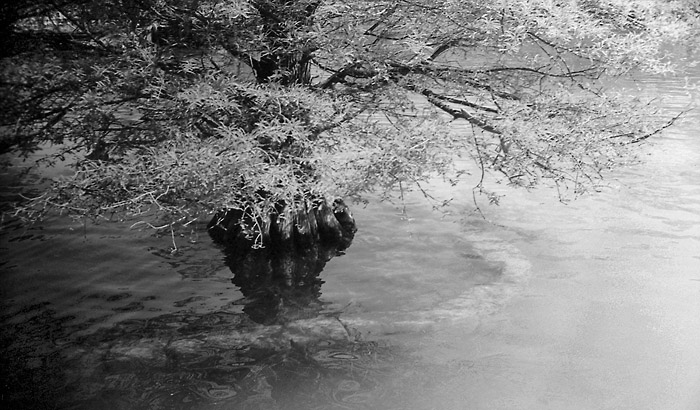
- Second one, same lake. The scanner did an awful job on this one and I'll have to work a better copy. You can notice some vignetting on the right side, probably the strong light source on daylight leaves its mark here, probablyhas something to do with having two filters stacked together.

- More vignetting and shutter capping on this but I was amazed to see how sharp this one was at full res.
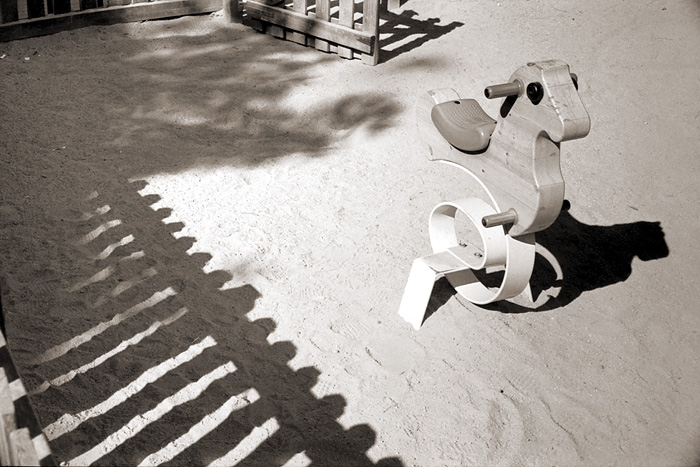
- Some forgotten chairs I found in an empty class at work..
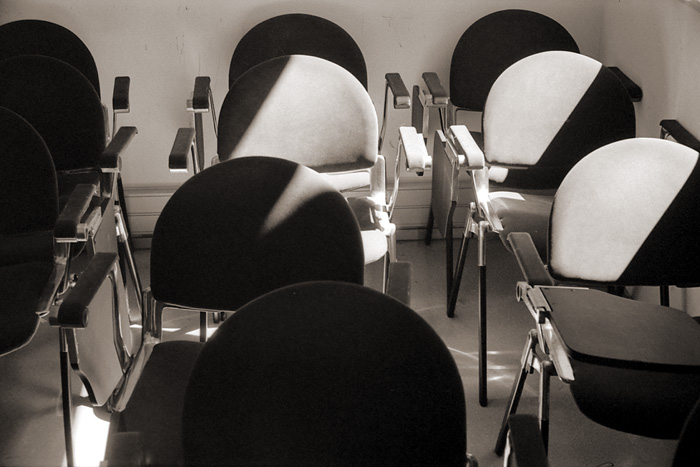
- Some street shots while wandering around...

- A test roll is not complete without an abandoned coke shot ;)

- And finally a couple more from the same park with that nice lake...


And that's all for now. For the next test when I find some free time I'm thinking on doing some night shooting, mainly trying to include some strong light sources in the frame as I've seem some examples which presentedhuge flare problems...
Btw, just as with the previous thread, the lens was unshaded but armed with a yellow K2 Hoya filter, film was Neopan 400 developed in Diafine and scanned in a Epson 3170. Only trouble I had is that with a non-working 1/1000speed, some shots came quite overexposed...
In Spanish we have a sentence which says 'Dios los crÃa y ellos se juntan', that means more or less that people with similar opinions, likings, hobbies, etc tend to meet somewhere sooner or later.
I belong to an internet community of photographers and camera lovers which enjoy sharing work and information and talking regularly in the cyber agora of the rangefinder forum. It was long ago that somebody there came up with a word for describing our sometimes compulsive need to lust for new photographic gear, G.A.S. or Gear Acquisition Syndrome.
Then of course, sometimes one likes to get something just for the pleasure of having and using it. That said, it also may act as a trigger for developing newer approaches whey they force you to work in a different way.
That's not probably the case of my last two GAS attacks, or maybe yes, who knows...
First place today is for the Voigtlander Bessa-T. The T is a 35mm film rangefinder camera with Leica-M lens mount and TTL meter built by Cosina Voigtlander, responsible also of a rangefinder renaissence with the models R, R2, R2s and R2c, T, R2a/R3a and now with his partnership with Zeiss for the new Zeiss Ikon rangefinder camera.

Curiously, this camera only has a coupled rangefinder built into the body, and not the usual viewfinder window. Apart from giving it a funny look, it also helps to reduce the price. Stick an external viewfinder on the accessory shoe and you'll have a great inexpensive M mount camera with an incredibly easy to focus and accurate rangefinder thanks to the 1.5x magnification. I plan on using it mainly with the (seen in the photo) truly excellent Voigtlander 35/2.5 pancake lens from the same manufacturer.
The coffee mug in the shot is also another newcomer, in this case from my NZ buddy Abel who is currently working for a network hardware company there.
My other (so far) GAS attack is a tiny and very nice Canon rangefinder lens. I just threw a playful bid on the infamous auction site and who was going to think that, I ended getting it for my maximum bid amount. It was still cheap (I think) mainly according to the going rate for similar lenses in the past.

The lens is a late version black/chrome 35mm f/2.8. I simply love 35mm lenses, to some people they are the rangefinder focal length par excellence. Maybe or maybe not, but to me 35 is my all time favorite length, the field of view suits very well my street shooting preferences, being wide but not too much, and offering a nice depth of field range for scale focusing and shooting a bit in the 'point & shoot' way, nice lens to register life around you.
The lens will probably live permanently attached to my Canon P who was claiming for a proper 35 since long ago. Of course I could have used the Voigtlander lens on the Canon, but as a friend of mine likes to say, 'Canon on Canon'. Then I added 'Voigtlander on Voigtlander, Leitz on Leitz, Jupiter on Zorki' etc ;)
In the end, it's clear that pictures will not improve by adding more equipment, but GAS is real and has no cure, so it may be better to simply accept it :)
And let's face it, finding bargains always makes you feel good !
A bit of introduction, I bought this lens some weeks ago from a member of the Leica Forum in photo.net, I had been curious about it for a while and the price was so good I just couldn't say no (as always, hehe), anyway, I promised to post some of my experiences with it there, and as I found the HTML code of the post I submitted, well, I thought it would make a nice blog entry as well. Remember, the lens is the Canon 50/1.2 made for Leica thread mount rangefinder cameras, it's a huge piece ofa lens, and often underrated.
- First impressions:
- The lens is quite big and reminds you pretty much to a normal SLR one. That said, it looks at home on a big camera such as the Canon 7, and for what I've seen, looks to be just the right size as well for the Epson RD-1. The focus throw is loooong but smooth, thanks Huw for 'disabling' the annoying infinity lock ! :) You can see that I've been using it with an empty filter ring that the previous owner placed there (thanks again) for security, as some filters may touch the protruding front element. Over that one I had a Hoya 2K yellow, at first I was afraid of having to stacked filters but found no visible vignetting at 1.2.
- Handling: I've carried this camera and lens for a while... and believe me, it is heavy. By adding that metal grip I made it even heavier but the extra handle came in handy while shooting and while walking with the camera in my hand. Here you have it on the Canon 7 side to the Canon P with the 50/1.8.

- First shots: To start, I did a series of shots placing objects at different distances and shooting at 1.2 to see how the lens managed the focus and oof areas. All these four shots were as close up as I could.

Then I switched focus to the second object starting from the back

Swallow DOF, mainy for the objects in front of the focus point, now for the next one
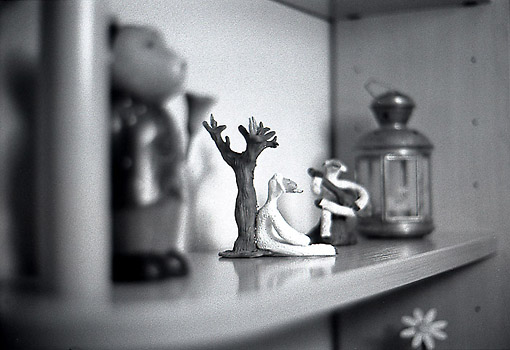
The lamp is clearly blurry now, and notice how the holes in the shelf in the background start to render as semi-circles.
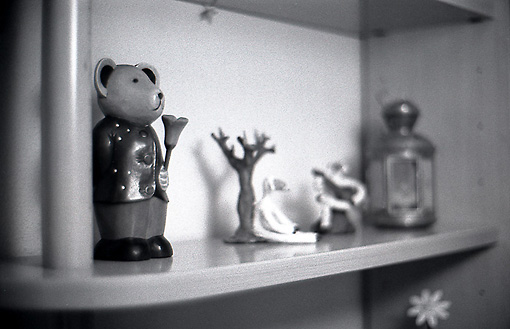
- Some portraits: I think that the lens may be in its favorite land when used for portraits where you want a massive oof effect.




- The end?
No, I must still so some more work with this one at other aperture ranges. At first I thought it would be too big and heavy for using it as a daily 50, and ... well, it is big and heavy but the chrome 50/1.8 is not exactly a light lens either so it's not that much of a problem. That said, I decided for this lens mainly for trying it in the 1.2-2 range, also, and as Huw stated in the ad, there's a tiny haze in the rear element that would probably improve the lens resolution/contrast performance if removed.
- Tech notes:
Just for the record, all these shots were taken using the lens on my Canon 7 body, film was Neopan 400 developed in Diafine. Negs scanned on a Epson 3170, but not that it matters much at this size. However, you can get an approximate idea of how the focus and oof areas behave. It's not the king of resolution at wide apertures, but probably it wasn't designed with that in mind :)
And yes... it's true, I admit. I also got this lens because it looks way cool ! ;^)
Classic cameras are dangerous things, some day, without you knowing how, one may get into your life and you'll suddenly experience yourself a great completeness feeling 'oh I finally have a real classic camera'. Two things are now possible, A) you play with it for a while, run a roll or two through it and then go find another more healthy hobby/interest, such as collecting used cotton buds or count the number of seconds in a day. B) you start to use that thing called internet to look for more information on your classic camera.
Choose B and you're sold, closed, door locked and key thrown to the river just at the point where the Niagara falls begin.
Guess what ? I chose B, so I'm one of those strange elements around which enjoys the sometimes compulsive need to buy, trade and use (and yes, sometimes, fondle) classic mechanical cameras.
Sometimes though, things are not as nice as we'd like, and some of the beauties come to us being far from perfect shape. It's then when somebody like me, scared of just looking at a jeweller's screwdriver, says something like 'uh oh, another shelf piece'. However, even a chicken guy like me has some successful episodes of hero (suicidal) behaviour from time to time. It has been the case with my just repaired/rebulit Agfa Isolette.

To burn the test roll in the camera, I headed to one of my favorite parks in Barcelona, La Ciutadella where at this time of the year you'll find loads of people enjoying the warm weather and also loads of photographic opportunities...

park readers